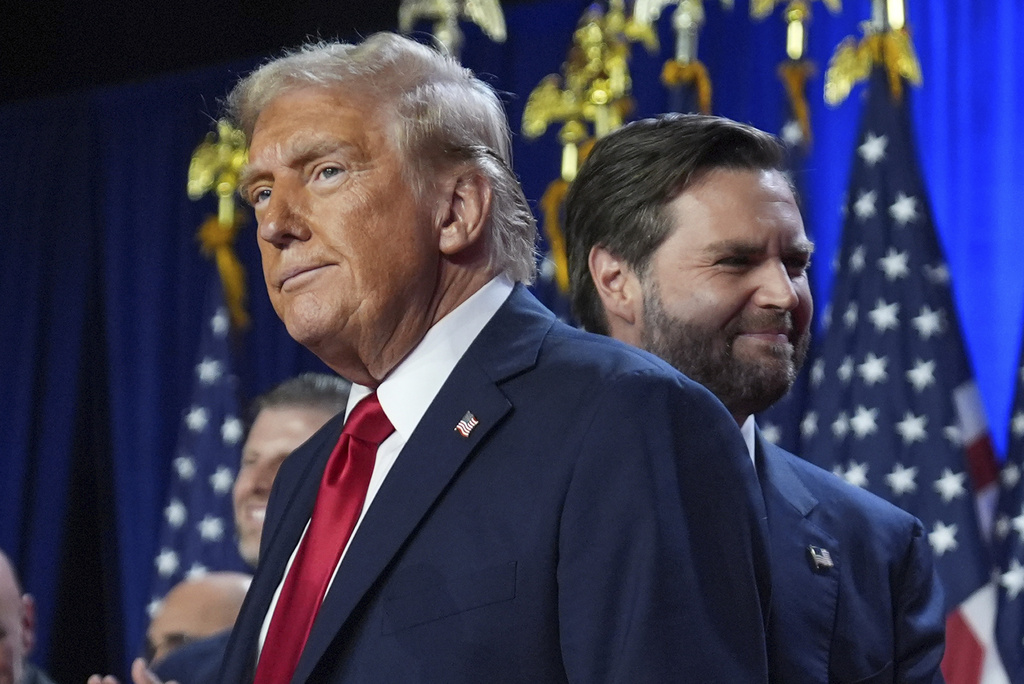Trump economic plan/ Trump tariffs/ U.S. economy/ immigration policies/ tax cuts/ inflation concerns/ Newslooks/ WASHINGTON/ J. Mansour/ Morning Edition/ Americans, frustrated with high prices despite steady economic growth, voted for change by electing Donald Trump. Trump’s promises include tariffs, tax cuts, and immigrant deportations, but many economists warn that these policies could lead to higher inflation, increased federal debt, and slowed growth.

Americans Hope for Economic Relief in Trump’s Second Term Quick Looks
- Trump’s economic goals: Plans to cut taxes, impose tariffs, and reduce undocumented immigration.
- Mixed economic outlook: Trump’s policies may raise inflation and increase the federal deficit.
- Voter frustration: Despite economic growth, high prices remain a concern for Americans.
- Expert warnings: Economists caution that tariffs and tax cuts could worsen inflation and debt.
Donald Trump’s Economic Promises: High Hopes and Big Risks
Deep Look
With President-elect Donald Trump poised to take office, many Americans anticipate a shift in economic policy. Despite steady economic growth, high prices remain a top frustration for voters, who expressed hope for relief by supporting Trump’s promises to cut taxes, impose tariffs, and address immigration.
Economic Landscape Post-Election
Trump inherits an economy performing well by most indicators, but still struggling with high costs that weigh heavily on households. The unemployment rate is at a low 4.1%, and growth continues at a healthy pace, with the U.S. among the strongest economies worldwide. Yet for many Americans, inflation—though on the decline since its pandemic-era peak—has left prices around 19% higher than in 2021, with everyday costs like groceries and housing affecting lower-income families most acutely.
A recent AP VoteCast survey showed 3 in 10 voters feeling financially “behind,” with the high cost of living, healthcare, and housing listed as primary concerns. Economist Douglas Holtz-Eakin notes that this discontent played a major role in Trump’s electoral win. “The real problem is the Biden-Harris team made people worse off, and they were very angry about it,” he said. Trump has promised change, but his policies may bring both relief and new challenges.
Trump’s Tariff Plans and Inflation Risks
Central to Trump’s economic vision is a sweeping tariff policy. He proposes raising tariffs on Chinese imports to 60% and applying a 10–20% “universal” tax on all other imports to reduce trade deficits and push for better trade deals. However, experts warn that these tariffs, effectively a tax on imports, would raise consumer prices in the U.S. and potentially worsen inflation. While Trump insists that foreign producers bear these costs, tariffs are typically paid by U.S. companies, which often pass the added costs to consumers.
Kimberly Clausing and Mary Lovely of the Peterson Institute estimate that Trump’s tariff plan could cost the average U.S. household $2,600 per year, straining household budgets further. Tariffs also bring the risk of retaliatory measures from other countries, reducing U.S. exports and hurting American businesses that rely on global markets. A projection by the Peterson Institute forecasts a possible increase in inflation by up to 9.3% within two years of implementing Trump’s tariffs.
The Impact of Immigration Policies on Labor Markets
Trump’s plans to deport millions of undocumented immigrants add another layer of uncertainty. Immigrants have played a crucial role in filling job shortages across industries as the U.S. workforce ages and baby boomers retire. Recent research from the Brookings Institution found that immigrants accounted for 73% of new workforce entrants over the past four years, allowing the U.S. to maintain steady growth without fueling excessive wage inflation.
A broad deportation campaign could disrupt labor markets, according to the Peterson Institute, which estimates that the removal of undocumented workers could shrink U.S. GDP by $5.1 trillion by 2028 and increase inflation by 9.1 percentage points. These figures underscore the delicate balance between labor supply, economic growth, and cost stability that has allowed the U.S. to navigate the post-pandemic economy.
Tax Cuts and Growing Debt Concerns
Trump has also pledged to extend and deepen tax cuts enacted during his first term. His plan includes extending the 2017 tax cuts, eliminating taxes on Social Security benefits, overtime pay, and tips, and further reducing corporate taxes for U.S. manufacturers. While popular among some voters and expected to spur short-term growth, the University of Pennsylvania’s Penn Wharton Budget Model warns that these cuts would add $5.8 trillion to the federal deficit over the next decade. Even if tax cuts stimulate some economic growth, the model estimates the deficit could still grow by over $4 trillion through 2034.
Federal debt has grown rapidly in recent years due to an aging population and increasing Social Security and Medicare expenses. Holtz-Eakin expressed concern over Trump’s ability to address these issues, citing a lack of appetite for cuts to entitlement programs or tax increases that could help balance the budget. “It’s not going to happen,” he said, referring to the likelihood of budget reform under Trump.
The Balancing Act of Trump’s Economic Plans
While Trump’s policies appeal to Americans frustrated with high prices, economists caution that these moves carry risks. Tariffs, immigration crackdowns, and tax cuts could drive short-term growth but may result in long-term challenges, such as increased inflation, debt, and reduced workforce availability. Nobel laureate economists recently issued a letter warning that Trump’s approach could ultimately lead to higher prices, deficits, and economic inequality.
“The rule of law and economic certainty are among the most important determinants of economic success,” the economists wrote. They cautioned that Trump’s strategies may destabilize these elements, which are crucial to sustainable growth.
Looking Forward
As Trump prepares to take office, voters will be closely watching how his policies unfold. While some Americans hope his return will restore the pre-pandemic economic stability, experts stress the potential for unforeseen consequences. Trump’s ambitious agenda brings optimism but also raises significant questions about the future trajectory of the U.S. economy.







